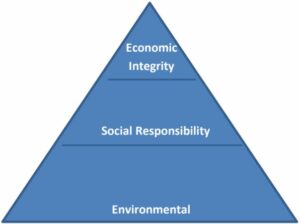
01 Mar What Is Sustainability?
Sustainability is a complex concept, which often leads to confusion over its meaning. In its simplest form, it can be defined as meeting the needs of the present, without compromising the needs of future generations.
Many believe that sustainability only refers to environmental preservation, but in reality it has two other pillars that are often overlooked. In order for something to be truly sustainable, there needs be a balance between the three pillars – environmental, social responsibility, and economic integrity – though that balance does not refer to the equality of these three pillars. Rather, similar to the concept of a balanced diet, which can be illustrated by a food pyramid, the tiers of a “sustainability pyramid” are determined by the importance of the longevity for our future generations. In the food pyramid example, the amount of each food group you should consume varies depending on its importance to your health. The bottom tier of the pyramid signifies the food group you should incorporate the most into a healthy, balanced diet, and the smallest tier at the top signifies the food group which you should have the least of.
In the sustainability pyramid, the bottom tier represents the environment. Without a healthy, resilient planet full of resources, our future generations will perish along with the rest of life as we know it. The second tier represents social responsibility. When people are treated equally and fair, they become more productive citizens and employees. When we have more productive citizens, we advance as a society. And when we you have more productive employees, our supply chains and economies become strengthened. Finally, the top tier represents economic integrity. No business can be sustainable without profit. However, when long-term investments are made in place of short-term ones, our economies and businesses will thrive for many futures to come. That being said, short-term profits don’t have to be omitted from decision-making entirely, but they should never trump the other two pillars during decision-making.

How Can I Determine Whether The Seafood I Am Purchasing Is Sustainable?
To understand the sustainability of the seafood sold at your grocery stores and restaurants, there are a few steps you can take.
1) Do your homework on the grocery stores and restaurants that you are purchasing your seafood from. Many
corporations include their sustainability policies and sourcing strategies on their company websites.
2) Contrary to popular belief, wild-caught seafood isn’t always more sustainable than farmed seafood. Do some
research on the species of seafood you wish to purchase. You may be surprised with that you find!
3) If doing your own homework seems like too much work, look for products that are certified as sustainable from globally accepted schemes. These certifications annually audit the farms, processing plants, fishing vessels, etc., to determine how sustainable their business practices are.
Examples of sustainability certification schemes include: Best Aquaculture Practices (BAP), Marine Stewardship Council (MSC), Aquaculture Stewardship Council (ASC), Alaska Responsible Fisheries Management (RFM), and Global G.A.P.
Beyond Seafood Sustainability Certifications – What Else To Consider Regarding The Sustainability Of The Seafood You Consume
All animal proteins place some kind of pressure on our natural resources. When looking at the sustainability of the farmed animal proteins that are in your diet, you should also consider how many resources are being used to raise the animal.
As you know, farmers need to provide the animals with food, water, and a place to live. Beyond the physical space that the animals live in, it takes land to grow the feed they eat. That makes how much feed the animals consume that much more important. Less feed means fewer resources used to raise our food and, therefore, more available for human use.
The amount of feed used will of course vary from farm to farm, depending on the farming methods used. But did you know that some animals are more efficient at turning feed into body mass? To determine how efficiently each type of animal does this, an indicator called a feed-conversion ratio (FCR) is used. An FCR is defined as the amount of feed used to gain one pound of body mass. A breakdown of the average FCRs for the top consumed sources of animal protein in the U.S. can be found below:
1) Tilapia(2): 1.2-2.0
2) Shrimp(2): 1.2-1.4
3) Salmon(2): 1.2-1.4
4) Chicken(1): 1.7
5) Pig(1): 2.9
6) Cow(1): 6.8
Pigs and cows require almost two to five times more feed than seafood! By choosing seafood more frequently, you not only decrease your chances of heart disease but also your impact on the world for generations to come.
How far did your seafood travel to get to you?
Ideally, you want to support your local fishermen and aquaculture farmers as much as possible. By doing this, you are reducing greenhouse gas emissions from transport and supporting your local economy. However, since about 90% of seafood sold in the U.S. is imported from all over the world, it can be hard to always choose local.
If you can’t find something local to your geographic location, products from neighboring geographic locations are a good next choice. The U.S. Alaskan fishery is a wonderfully managed fishery where you can purchase salmon, pollock, and cod from. You can also find sustainable U.S. trout and catfish farms sprinkled around the country. The wild scallop and lobster fisheries in northwestern parts of the Atlantic Ocean are also well managed, giving you lots of local selections to consider.
Written by: Kari Valickas, kvalickas@easternfish.com
Sources
(1) Global Aquaculture Alliance. Why It Matters. https://www.aquaculturealliance.org/what-we-do/why-it-matters/
(2) FAO. Improving Feed Conversion Ratio and Its Impact on Reducing Greenhouse Gas Emissions in Aquaculture. http://www.fao.org/3/a-i7688e.pdf


